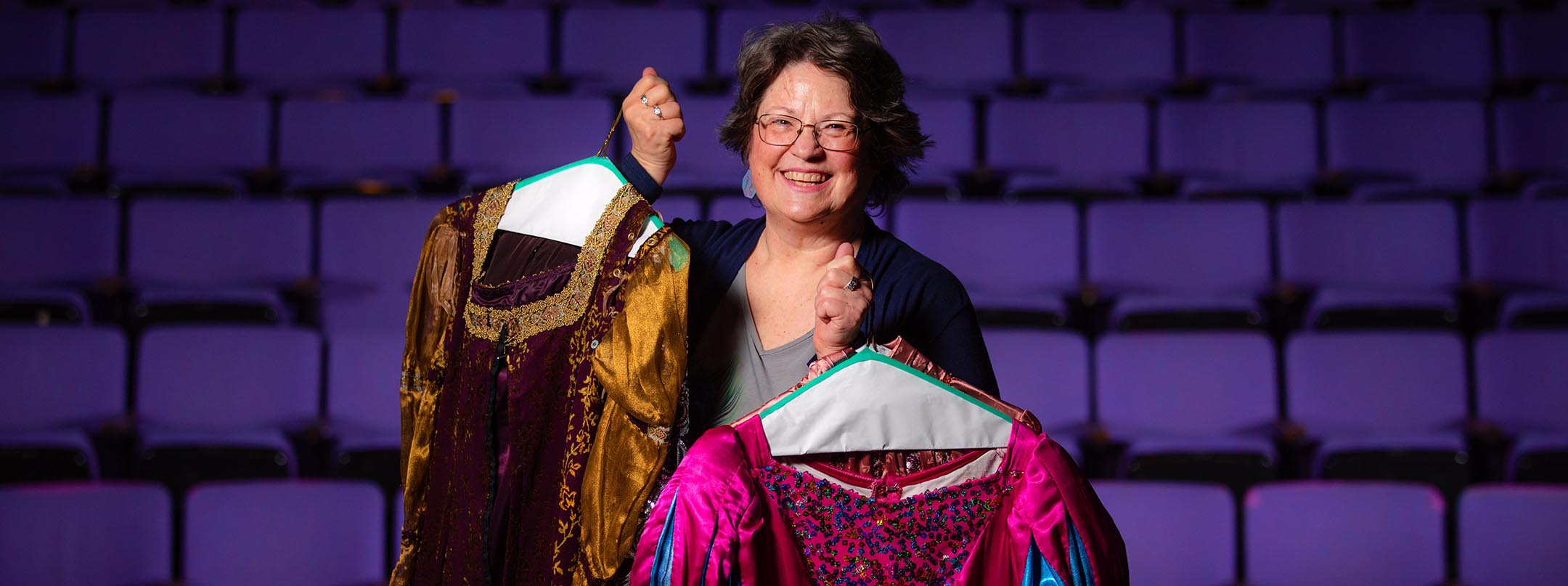Written by Jeff Budlong | Photo by Christopher Gannon
Jan. 23, 2024
She brings ISU Theatre ideas to life

Asked to describe what costume shop supervisor Doris Nash does, Kelly Schaefer pauses to come up with the right analogy to encompass it all.
"She seems to have Mary Poppins' bag of tricks, plus tips and knowledge to pull things out and make it all happen," said Schaefer, a theater teaching professor who works with Nash in the costume shop. "Doris can take a pencil sketch on a napkin that I might do and bring it to life. It is incredible because it is a very small group of people who can do it."
Since becoming the costume shop supervisor in 1989, Nash has worked with everyone from professional costume designers to Iowa State freshmen, making their visions a reality for more than 200 ISU Theatre productions.
Nash grew up with dreams of being a triple threat on Broadway -- singing, acting and dancing. It may not have happened in New York, but she has been a cast member in an Iowa State production and, to round out her many talents, Nash is a member of two choirs. The versatile Iowa native holds bachelor degrees in vocal performance from Coe College in Cedar Rapids and clothing and textiles from Iowa State.
Schaefer said the university is lucky to have someone of Nash's skill and dedication. She has honed her skills working summers with the Santa Fe Opera and the Colorado Shakespeare Festival. The former is world-renowned, attracting performers from across the globe.
Doris can take a pencil sketch on a napkin that I might do and bring it to life. It is incredible because it is a very small group of people who can do it.
Kelly Schaefer, theater teaching professor
The costume shop
Down a flight of stairs past the entrance to Fisher Theater is where Nash performs her brand of magic. The shop is as humble as its leader, with shelves of fabric, sewing machines and tables. A white board on the costume shop's steel doors helps Nash manage production tasks.
Before a stitch happens, Nash sits down with a designer -- whether a student or faculty member or professional -- to review their sketches or photographs to determine what is and isn't possible. Time is always a factor.
"We start by getting the measurements of the actors and I start drafting a pattern," she said. "Once it's assembled, we do a fitting with the actor, take notes from that and complete the costume."
To hear her tell it, the job sounds pretty simple. But it is her meticulous ways and years of experience that allow her to eye correct sizes before ever measuring.
"She doesn't let her ego or personal views get in the way," said Schaefer, who has worked with Nash for 13 years. "She is completely objective about what needs to happen to bring a show to life."
Each year, Nash directs a group of students who stitch together her designs. She currently has seven students under her direction with varying levels of skill at the sewing machine. Nash works to build their skills -- both hand and machine sewing -- giving them more intricate and demanding tasks as they prove their ability.
The clock is always ticking toward opening night on Nash and the stitchers, who feel fortunate if they have six weeks to put costumes together. She has developed a network of other costume shop leaders, connected through Facebook, who share tips and tricks, many of which she passes on to students.
"She is incredibly dedicated to the students," Schaefer said. "She has been instrumental in helping the department become more inclusive of all of our students."
For example, Nash helped develop private dressing rooms and set up a small pantry where students can make a quick, hot meal during a busy day at Fisher.
It's a process
Nash transforms ideas into reality by creating fabric patterns and mocking up costumes. When she first started, finding the right fabric meant stopping at several stores across central Iowa. The internet has made that process simpler and faster.
What truly sets Nash apart, Schaefer said, is the pattern design and mathematical calculations that make a costume fit just right -- it's the long hours before the curtain goes up that patrons don't see.
Once Nash turns the fabric into a pattern and cuts the pieces, the student stitchers sew it following her instructions. Of course, flexibility is always important.
"Sometimes things also will take a left turn," Schaefer said.
Keeping track of it all
Multiple performances each year mean Nash and ISU Theatre maintain quite the costume wardrobe.
"We have a big warehouse on the east end of town that houses 20 racks of costumes on two levels," she said. "Because of the shows we have done, we have a lot from a certain period and not as much from others."
Despite the number of costumes that go back further than 1989, Nash maintains an inventory that simplifies costume retrieval and updates. The department also has a costume sale every few years to keep the numbers manageable.